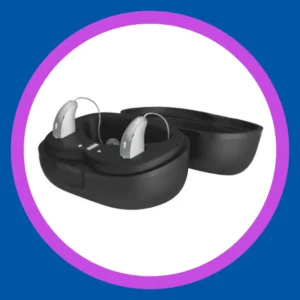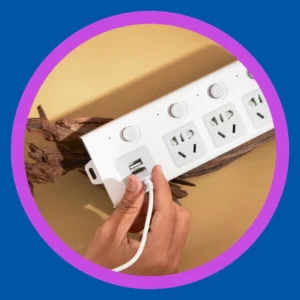How to Take Care of Your Hearing Aid Charger
A hearing aid charger plays a key role in keeping your devices working every day. Rechargeable hearing aids rely on this charger to provide consistent power. Without proper care, your charger can affect hearing aid performance and battery life.
This guide will show you how to care for your hearing aid charger, avoid common mistakes, and ensure your rechargeable hearing aids stay charged and reliable.
Why Your Charger Deserves Some Attention
Your charger does more than power your hearing aids. It protects the internal lithium-ion batteries developed originally by NASA that help your devices last 18–24 hours per charge. These batteries usually last four to five years when charged and maintained correctly. Taking care of the charger helps preserve both the batteries and the hearing aids themselves.
Find out more about choosing a hearing aid battery.

Daily Charging Routine: What You Should Know
Daily charging keeps your hearing aids ready and reliable. Here’s how to do it right:
- Charge Every Night: Always charge your hearing aids overnight—even if they’re not fully drained.
- Use the Right Charger: Only use the charger and cable that came with your hearing aids.
- Let the Light Guide You: The LED light on your charger tells you if your hearing aids are charging properly.
- Don’t Unplug Too Soon: Wait until the light turns solid before removing your hearing aids.
- Handle with Care: Always hold your hearing aids by the body, not the wire.
Daily charging protects your battery health and helps your devices stay fully functional.
Discover more about the top hearing aid accessories.
How to Charge Lithium-Ion Hearing Aids
Lithium-ion batteries require consistent and careful charging. Follow these simple steps:
- Wipe Hearing Aids Clean: Remove debris and moisture before placing them in the charger.
- Insert Correctly: Place them in the marked slots. The charger will turn them off automatically.
- Watch for the Light: Blinking means charging; solid light means fully charged.
- Don’t Yank the Wire: Remove the hearing aids by the casing—not the wire.
These small actions prevent unnecessary wear and preserve performance.

How to Protect Lithium-Ion Battery Life
Extend your battery’s lifespan by following these tips:
- Avoid Deep Discharges: Never let the battery go completely dead.
- Charge Every Day: Even if unused, charge your hearing aids nightly.
- Avoid an Unplugged Charger: Don’t store hearing aids in a dead charging station.
- Turn Off for Long Breaks: If unused for days, turn them off and store safely.
These habits help maintain peak battery performance over the years.
Explore hearing aids with Bluetooth and noise-canceling.
Where and How to Store Your Charger
Location matters. Store your hearing aid charger in a safe and stable environment:
- Stay Cool and Dry: Avoid humidity and keep away from extreme temperatures.
- Use a Nightstand or Dresser: Avoid storing your charger in the kitchen or bathroom.
- Avoid Sunlight and Heat: Never leave it on a windowsill or in a hot car.
Proper storage prevents heat damage and moisture buildup, two common causes of charger failure.
Charger Maintenance: Cleaning and Inspection Tips
A clean charger works better and lasts longer. Here’s how to keep it in top shape:
- Use a Soft, Dry Cloth: Wipe down the charger regularly to remove dust.
- Avoid Liquids: Never use water or cleaning fluids.
- Brush Charging Ports: Use a soft brush to remove debris from tight spots.
- Clean Inserts Separately: Wash custom inserts with warm water and dry completely.
Cleaning weekly helps prevent buildup that can block charging connections.
Learn how to stay safe with hearing loss.
Six Smart Habits for Rechargeable Hearing Aids
Caring for your hearing aid charger also means caring for your rechargeable hearing aids. Follow these six habits:
- Wear Them Daily: Use your hearing aids at least six hours per day.
- Avoid Battery Drain: Never let hearing aids or chargers go completely dead.
- Use Original Equipment: Stick to the charger and wall plug provided by the manufacturer.
- Plug Directly Into the Wall: Skip USB ports and extension cords.
- Monitor Battery Life: Replace the battery or device if charges don’t last a full day.
- Bring Charger to Appointments: Your hearing care provider may test the charger’s performance too.
Following these habits extends the lifespan of your charger and devices.
Common Charger Problems and Easy Fixes
If your charger isn’t working as expected, try these steps first:
- Re-seat the Hearing Aids: Make sure they are placed correctly in the charger.
- Check the Lights: No light? Check the cord, outlet, or seating position.
- Clean the Contacts: Dirty contacts can interrupt charging.
- Reset the Charger: Some chargers offer a reset option—check your manual.
Quick checks like these can save time and prevent unnecessary repairs.
When to Replace the Battery or Charger
Your lithium-ion batteries won’t last forever. Here’s how to know when it’s time for a replacement:
- Short Battery Life: If the charge doesn’t last more than six hours, it’s time to call us.
- Visible Wear: Cracks, loose wires, or damage signal it’s time for a new charger.
- Age of Device: After four or five years, you may need new hearing aids.
Staying alert to these signs helps you avoid charging disruptions.
What to Bring to Your Hearing Appointment
Your charger isn’t just an accessory—it’s part of your full hearing solution. At your appointment, bring:
- Your hearing aids
- Your charger
- Any cords or accessories
Your hearing care provider may check the charger’s ports, wear and tear, and debris buildup. This helps detect issues early.

Final Tips to Keep Your Charger Working Like New
Here’s a quick summary of the best ways to protect your charger:
- Always clean with a dry cloth
- Avoid exposing it to water or cleaning fluids
- Don’t store it in humid or hot locations
- Use the original USB-C charging cable
- Plug it into a wall outlet, not a USB port
- Don’t yank on the power cord
- Follow all manufacturer instructions
- Inspect regularly for signs of damage
A little care goes a long way in protecting your investment.
Talk to Your Local Hearing Care Provider
If your hearing aid charger isn’t working properly or you have questions, we’re here to help. At Stanford Hearing, we provide ongoing support for all your hearing needs, from fittings to charger maintenance.
Let us help you keep your hearing aids running smoothly.
Contact Stanford Hearing today to schedule a checkup or troubleshooting appointment.
